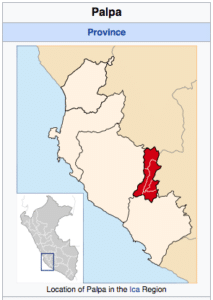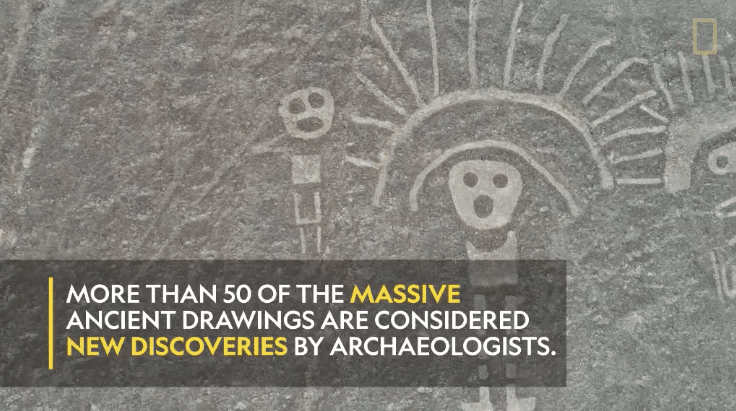by Teresa Yanaros,
I was shocked to find out about National Geographic’s report of 50 “new” Nazca Lines in Peru.
Peruvian archaeologists have discovered more than 50 new examples of mysterious desert monuments traced onto the earth's surface in incredibly fine lines. The team collaborated with the GlobalXplorer initiative, founded by Sarah Parcak (@indyfromspace): https://t.co/qRmFEtKlOy pic.twitter.com/mMtwUdPkcq
— National Geographic Society (@InsideNatGeo) April 5, 2018
The Nazca Lines are a series of geoglyphs in the desert of Southern Peru.
What is a Geoglyph?
Geoglyphs – drawings on the ground made by removing rocks and earth to create a “negative” image.
-Jason Golomb
This interesting phenomenon has been featured across many popular media platforms including Smithsonian and National Geographic, and has shown up on the popular History Channel show, Ancient Aliens.
National Geographic made a video about the new discovery.
Let’s Take a Step Back
Main stream media suggests that in 1940, the historian Paul Kosok was the first to discover the bird-shaped Nazca Line from a plane, which catapulted his research into the phenomenon. It makes you wonder, if we’ve been studying these historical landmarks from above since 1940, how are we just now finding out there are 50 more lines than initially discovered?
Well, I looked a little deeper and learned that Yamagata University from Japan opened a research center there in 2012 with the intention to study the area for the next 15 years. They’ve been there since 2006, when they found approximately 100 new geoplyphs.
World’s Only Research Team on Nasca Lines and Geoglyphs
The Research team from the Faculty of Literature and Social Sciences of Yamagata University has continuously discovered large-sized Nasca Lines and Geoglyphs. For further research and protection of this world’s cultural heritage, the Yamagata University Institute of Nasca was founded in October 2012 in the City of Nasca, Peru. It is the only research group in the world that the Peruvian government gives a permission to conduct on-site field study in the long run. Yamagata University is playing the central role in conducting international collaborative research with the group of specialists in anthropology, archaeology, geography, psychology, information science, conservation science, zoology and chronology.
Is it not interesting that this is the only research team in the world allowed by the Peruvian government to study the lines?
Either way, I have another question. Why weren’t we as a human race taking to the skies long before this research team dropped anchor in Peru in 2006? Surely we had the capacity to fly planes over head and take pictures after the initial discovery of the bird-shaped figure in 1940?
Next, National Geographic claims that “Peruvian archaeologists armed with drones” discovered the 50 new lines in an adjacent province to the one where the original Nazca Lines were found. Some of these lines can even be seen from the hillside without a view from the sky.
Here is the Nazca Province:

And here is the Palpa Province, where the 50 new lines were found:

What happened here? How did the Peruvian archaeologists somehow discover 50 more shapes beyond what the Japanese researchers found? Wouldn’t the Japanese researchers have drones or planes themselves?
It’s 2018. Yamagata University has been there since 2006. It is hard to believe that the team did not immediately map out the grid of the area. I would assume that would be one of the first and most important tasks on the list as soon as they arrived on site.
I will digress and give credit here though, I assume it’s a massive project and there are many teams of people from all sides trying to add into the research. Let’s just say for all intents and purposes, the Peruvians and Japanese (and whomever else) are working together to build a full picture of what’s going on in the Peruvian desert.
Peru’s Ministry of Culture archaeologist Johny Isla, is the Nasca lines’ chief restorer and protector.
Michael Greshko of National Geographic said,
“Isla’s work is extraordinarily difficult, and made even harder by spotty maps. Of the estimated 100,000 archaeological sites in Peru, Isla’s colleague Castillo says only about 5,000 have been properly documented on the ground. Even fewer have been mapped from the air.”
I’ve been to Coba, a historical site in Mexico, and talked to some of the locals about the process of uncovering these historical sites. They guessed that about 80 percent of the pyramids, buildings, artifacts, and other important history was still buried under the ground. They simply didn’t have enough man power, money, or interest from anyone to tackle such a massive project.
It makes you wonder a few things:
- Why is the operation so secretive? The government has a strangle-hold on who is allowed to perform on-site research
- Why is the operation so disorganized? They are still finding more shapes when we’ve had technology to map a grid of the area for a while now. It also sounds like we could use some more man-power on the project.
- Why are we not more interested in focusing funds and efforts to places like Peru and Mexico so that we can help uncover more information about our past?
What is the full story here?
We as a human race need to refocus our energies on what is truly important for our culture and society to grow. We must focus our collective mind on the deeper knowledge that lies dormant in our world. We have answers all around us. We must focus our conscious awareness on uncovering knowledge, and not squander our attention on meaningless entertainment and various hamster wheels that take us nowhere.
Next, I believe there’s a deep level of mind control occurring by the dark occult elite keeping in a certain vibration that discourages us from digging into our past to uncover more answers about the nature of our reality. We are prevented from rediscovering the magic in our world by believing that there are more important things in our immediate field of experience than something covered in dirt. Sure, you might read an article on National Geographic and think, “Oh, that’s cool. They discovered a shape of an animal in the desert.”
But deeper meaning infuses these discoveries. Think about it. We are discovering so much about our Earth, even now, in this day and age where the main stream education and media try to tell you that we’ve got it all figured out. You feel small and imprisoned and insignificant because you live in a box and pay the man to rent your little corner of the world. But there’s a whole world out there that we have yet to explore! If adults became, once again, like children and allowed their spirits to fly free out into the world of beauty, we could once again become conquistadors; adventurers. We would be more inclined to break free of our hamster wheels and chains and go out into the world and co-create an Earth where we learn and grow with our Earth Mother, instead of turning away from her.
Think about how the dark occult elite can use red tape to steer circumstances in their favor. Their goal? To keep us asleep and the power and knowledge in their hands. If red tape can be implemented into archaeological operations across the board, there is less risk for the general population to “wake up” to the beautiful world around them. The red tape created by lack of project funds, governmental restrictive access to sites, and mind control to steer the masses from public interest in these projects, could fuel an operation to seed this historical information into the public slowly, because the “powers that be” have decided that the sheer “unbelievability factor” inherent within the discoveries would be too much for the general populace.
What are the implications of the society that lived oh so long ago which created these large beautiful shapes and lines across the desert? Not to mention, if they were making these shapes so enormous so that the full breadth and shape of the figure could only be fully appreciated from the sky, why were they making these shapes in the first place?
Did they have a means of air travel long before the main stream narrative suggests? Or might they have been trying to communicate with other beings from the sky?
Either way, let’s remain diligent and make sure that when we hear these stories being dripped into the main stream that we are asking the deeper questions about the implications of the messages.
Sources:
https://www.yamagata-u.ac.jp/en/research/highlights/lit1/
https://news.nationalgeographic.com/2018/04/new-nasca-nazca-lines-discovery-peru-archaeology/
https://en.wikipedia.org/wiki/Nazca_Lines
https://www.nationalgeographic.com/archaeology-and-history/archaeology/nasca-lines/
Image Sources:
https://en.wikipedia.org/wiki/Palpa_Province
https://en.wikipedia.org/wiki/Nasca_Province
The preceding is a Stillness in the Storm original creation. Please share freely.
About The Author
Teresa Yanaros, an author and millennial advocate for spiritual enlightenment and disclosure, shares news and inspirational perspectives through her professional multi-media project “Divine Frequency.” Her upbeat attitude and intense passion for driving through truth and change act as a catalyst for her philosophical and cosmic teachings. Follow on Facebook, Twitter, and YouTube. Support independent media on Patreon. Sign up for a Tarot Reading, and Shop Divine Frequency.
Read more articles by Teresa Yanaros.
Like our work? Support this site with a contribution via Paypal, cryptocurrencies, or P
This article appeared first on Stillness in the Storm.
This article (Peruvian Archaeologists Discovered ‘New’ Nazca Lines: How is This Possible?) by Teresa Yanaros originally appeared on StillnessintheStorm.com and is free and open source. You have permission to share or republish this article in full so long as attribution to the author and stillnessinthestorm.com ar

Leave a Reply